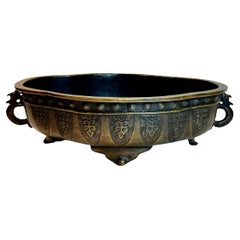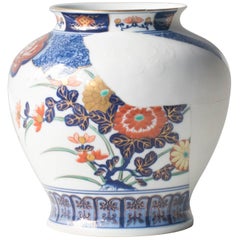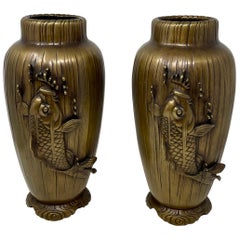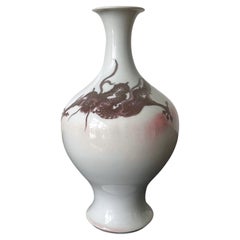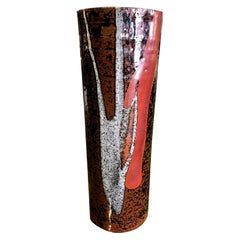Japanese Vases and Vessels
Mid-20th Century Anglo-Japanese Japanese Vases and Vessels
Bamboo, Rattan
1880s Antique Japanese Vases and Vessels
Bronze
2010s Showa Japanese Vases and Vessels
Ceramic
Late 19th Century Antique Japanese Vases and Vessels
Bronze
Early 1900s Japonisme Antique Japanese Vases and Vessels
Porcelain
1960s Showa Vintage Japanese Vases and Vessels
Earthenware
Early 1900s Art Nouveau Antique Japanese Vases and Vessels
Ceramic
19th Century Antique Japanese Vases and Vessels
Earthenware
Late 20th Century Modern Japanese Vases and Vessels
Porcelain
Early 19th Century Japonisme Antique Japanese Vases and Vessels
Porcelain
1960s Post-Modern Vintage Japanese Vases and Vessels
Porcelain
21st Century and Contemporary Meiji Japanese Vases and Vessels
Porcelain
19th Century Japonisme Antique Japanese Vases and Vessels
Bronze
19th Century Meiji Antique Japanese Vases and Vessels
Bronze
20th Century Japanese Vases and Vessels
Metal, Enamel
19th Century Antique Japanese Vases and Vessels
Porcelain
1880s Meiji Antique Japanese Vases and Vessels
Porcelain
1980s Mid-Century Modern Vintage Japanese Vases and Vessels
Art Glass, Ceramic
19th Century Antique Japanese Vases and Vessels
Ceramic
19th Century Meiji Antique Japanese Vases and Vessels
Pottery
18th Century Edo Antique Japanese Vases and Vessels
Ceramic
19th Century Antique Japanese Vases and Vessels
Porcelain
Late 20th Century Showa Japanese Vases and Vessels
Porcelain
Early 1900s Art Nouveau Antique Japanese Vases and Vessels
Bronze
19th Century Meiji Antique Japanese Vases and Vessels
Pottery
19th Century Japonisme Antique Japanese Vases and Vessels
Bronze
1980s Mid-Century Modern Vintage Japanese Vases and Vessels
Art Glass, Wood
Mid-20th Century Mid-Century Modern Japanese Vases and Vessels
Pottery
Late 19th Century Meiji Antique Japanese Vases and Vessels
Copper, Enamel
21st Century and Contemporary Japanese Vases and Vessels
Bronze
Late 19th Century Antique Japanese Vases and Vessels
Bronze
Late 19th Century Meiji Antique Japanese Vases and Vessels
Enamel
Early 20th Century Taisho Japanese Vases and Vessels
Porcelain
Early 20th Century Taisho Japanese Vases and Vessels
Bronze
21st Century and Contemporary Meiji Japanese Vases and Vessels
Gold
1980s Mid-Century Modern Vintage Japanese Vases and Vessels
Art Glass, Ceramic
21st Century and Contemporary Meiji Japanese Vases and Vessels
Porcelain
1960s Mid-Century Modern Vintage Japanese Vases and Vessels
Ceramic
Late 19th Century Antique Japanese Vases and Vessels
Porcelain
20th Century Mid-Century Modern Japanese Vases and Vessels
Ceramic
19th Century Antique Japanese Vases and Vessels
Ormolu
21st Century and Contemporary Japanese Vases and Vessels
Porcelain
19th Century Meiji Antique Japanese Vases and Vessels
Porcelain
1980s Vintage Japanese Vases and Vessels
Porcelain
Late 19th Century Meiji Antique Japanese Vases and Vessels
Enamel, Copper
Late 19th Century Meiji Antique Japanese Vases and Vessels
Brass, Enamel
1880s Japonisme Antique Japanese Vases and Vessels
Ceramic
Late 20th Century Post-Modern Japanese Vases and Vessels
Stoneware, Ceramic
19th Century Meiji Antique Japanese Vases and Vessels
Enamel
1830s Antique Japanese Vases and Vessels
Porcelain
Late 19th Century Meiji Antique Japanese Vases and Vessels
Gold
1870s Chinese Export Antique Japanese Vases and Vessels
Porcelain
19th Century Meiji Antique Japanese Vases and Vessels
Copper, Enamel
Late 19th Century Antique Japanese Vases and Vessels
Bronze
Early 20th Century Japanese Vases and Vessels
Porcelain
18th Century Antique Japanese Vases and Vessels
Porcelain
Mid-20th Century Mid-Century Modern Japanese Vases and Vessels
Bronze
Early 20th Century Meiji Japanese Vases and Vessels
Brass, Enamel
Late 19th Century Antique Japanese Vases and Vessels
Porcelain
19th Century Meiji Antique Japanese Vases and Vessels
Bronze
Read More
Kazuyo Sejima’s Flowering Tree Blooms Year-Round
The brilliantly simple design turns a modest bouquet into a major statement.
African Travel Plans on Hold? This Ardmore Leopard Vase Brings the Beauty of the Savanna to You
It’s an excellent example of the sought-after ceramics coming out of South Africa’s KwaZulu-Natal province.
With a High-Tech Flagship and Cool Collabs, Lladró Is Breaking the Mold for Porcelain Production
Thanks to its new leadership, the Spanish maker of figurines, busts and lighting is on a mission to update the art of porcelain for the 21st century.
Zoë Powell’s Magnolia 05 Vessel Is Handmade from Clay She Unearthed Herself
The free-form stoneware piece is inspired by the magnolia tree and its associations with home.
8 Ways to Breathe New Life into a Space with Plants
The pair behind the Instagram account @houseplantclub share their tips for making any room of the house gloriously green.
This Vivacious Teapot Has Agnes Martin on One Side and Jean-Michel Basquiat on the Other
Ceramist Roberto Lugo brings a street-art sensibility to a dainty serving vessel while paying homage to his artistic heroes.
This Rare Set of 100 Alessi Vases Includes Designs by Scores of International Artists
Alessandro Mendini, Michael Graves, Ettore Sottsass and other design luminaries contributed to this unusual collection of porcelain wares representing a time capsule of late-20th-century decorative art.
10 On-Point Vessels for Flaunting Your Houseplants and Bouquets
Whether you're a genius gardener or have your florist on speed dial, every stem in your home deserves the best.

